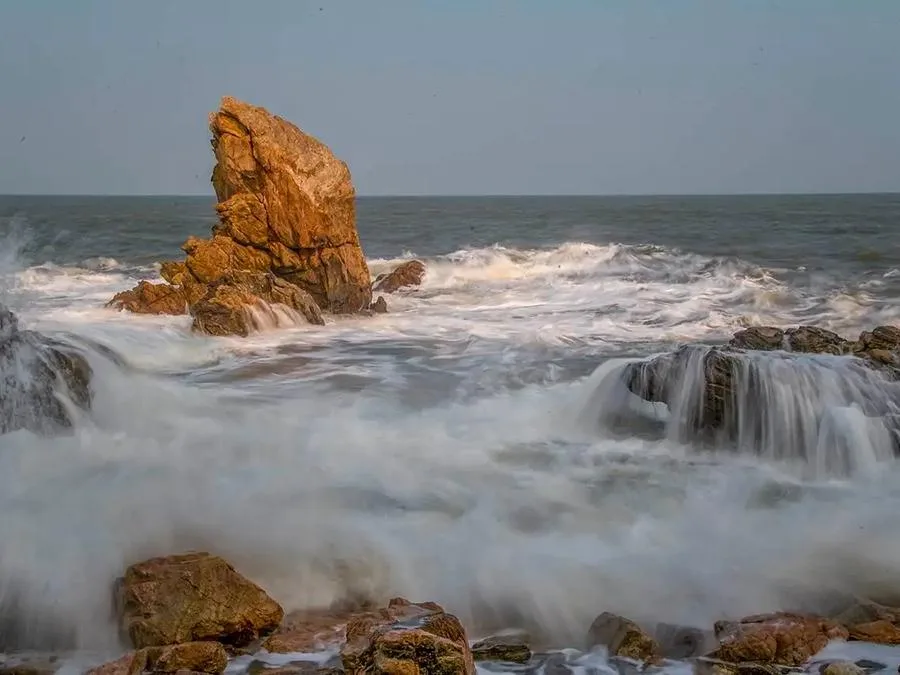Rushan Silver Beach (乳山银滩) is located on the southeast coast of Rongcheng City, Shandong Province, known as the last golden coastline of the Jiaodong Peninsula and often referred to as the “Qingdao Garden”. The area boasts rich natural and cultural landscapes, featuring gently sloping and flat beaches with fine, soft, and pristine white sand, making it one of the best beaches in northern China.
Visitors can enjoy activities such as watching the sunrise, crab-catching in the early morning, fishing and swimming during the day, and leisurely walks along the seaside paths in the evening. The air is fresh, and the environment is pleasant, making it an ideal destination for vacations and recuperation. Each year, many tourists from cities like Beijing and Tianjin visit here for leisure.
During the summer, beach activities such as beach motocross and jet skiing are available, and the fees are reasonable. Rushan Silver Beach offers a serene and enjoyable escape amidst its natural beauty and recreational opportunities.
Table of Contents
- Basic Information
- Location and Transportation
- Highlights of Rushan Silver Beach
- Vlog about Rushan Silver Beach
Basic Information
| Estimated Length of Tour | 2 hours |
| Ticket Price | Free |
| Opening Hours | 24 hours a day throughout the year |
| Telephone Number | 0086-0631-6722345 0086-0631-6771888 |
Location and Transportation
Rushan Silver Beach is located at 868 Changjiang Road, Rongcheng City, Weihai, Shandong Province, China. It stretches 21.3 kilometers from east to west and is 3 kilometers wide from north to south. The beach is situated 13 kilometers away from the old town area of Rongcheng City, 130 kilometers from Qingdao, 90 kilometers from Yantai, and 90 kilometers from Weihai.
To get there, you can take bus Rushan 201, Rushan 202, Rushan 210, or Rushan 212 and get off at Haidu Garden South Gate Stop (海都花园南门站).
Highlights of Rushan Silver Beach
Immortal Bridge (仙人桥)

Spanning 15 meters in length and 9 meters in width, with an arched height of 5 meters, the Immortal Bridge connects the sea and the land. According to legend, the Japanese Buddhist monk Ennin once preached here. Visitors can ascend to the top of the bridge, where they can feel its slight tremors under the crashing waves, giving a surreal sensation of stepping between heaven and earth. During low tide, smooth rocks under the bridge are exposed, and the cool breeze inside the arch provides a perfect spot for relaxation.
Three-View Pavilion (三观亭)

Legend has it that in 210 BC, during his eastern travels, Emperor Qin Shi Huang visited this site and climbed to the southern end of the cape to observe the sunrise over the horizon, the rolling waves during the day, and the return of Xu Fu’s expedition searching for the elixir of immortality at night. Later, the Three-View Pavilion was built here for tourists to enjoy views of the sunrise, the rolling waves, and the pine forest. North of the pavilion stretches a 22-kilometer coastal forest belt covering 13,000 hectares, designated as a national-level coastal protection forest planted during the 1950s and 1960s.
Immortal Staff (仙人杖)

Located at the eastern end of Beidou Bay, a group of purple-colored rocky reefs emerges from the sea. Among them, a massive pillar-shaped reef rises abruptly from the sea, towering more than 10 meters high. From a distance, it resembles a long staff inserted into the sea. Legend has it that before the Eight Immortals crossed the sea, they gathered here to discuss their voyage. During a dispute between Iron Crutch Li and Lv Dongbin, Iron Crutch Li angrily threw his staff into the sea. Miraculously, it transformed into the towering reef known as Immortal Staff, surrounded by numerous reefs which are also habitats for sea crabs. Visitors can enjoy the thrill of crab catching here, adding a touch of adventure and perhaps a fresh seafood meal to their visit.
Duofu Mountain (多福山)

To the north of Bailang Bay stands Duofu Mountain, reaching an altitude of 395.6 meters. Originally named Dagushan (Big Solitary Mountain), it was later renamed Duofu Mountain because it was perceived as a blessing descending from heaven. The summit of Duofu Mountain is often shrouded in clouds and mist. Beneath a large rock on the peak lies a natural liquid pool, known as the “Jade Liquid Heavenly Pool,” which collects sweet dew throughout the year. Despite its small size, this pool never dries up in winter or summer, believed to have miraculous healing properties and the ability to prolong life. The mountain is adorned with unique trees and exotic flowers, amidst scattered bizarre rocks, the most striking of which is a giant rock resembling an eagle, facing the sea with its head held high.
To the west of Duofu Mountain lies San Guan Temple and other ancient sites. Every year on the 15th day of the fourth lunar month, thousands of people gather here for the Mountain Festival, creating a vibrant and bustling atmosphere.


